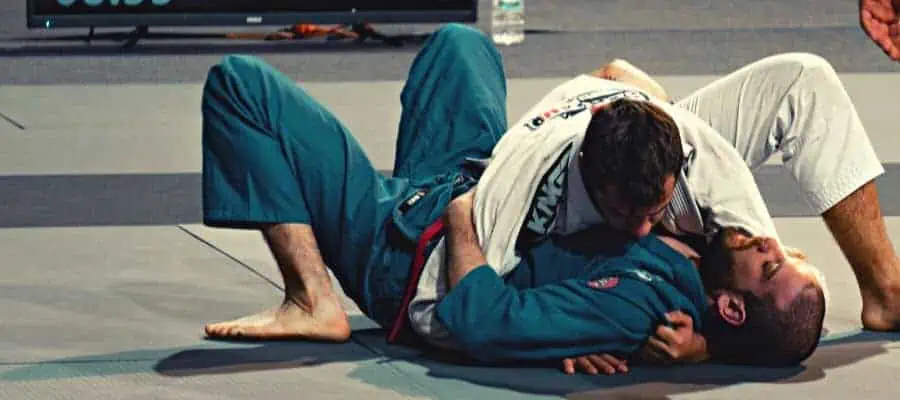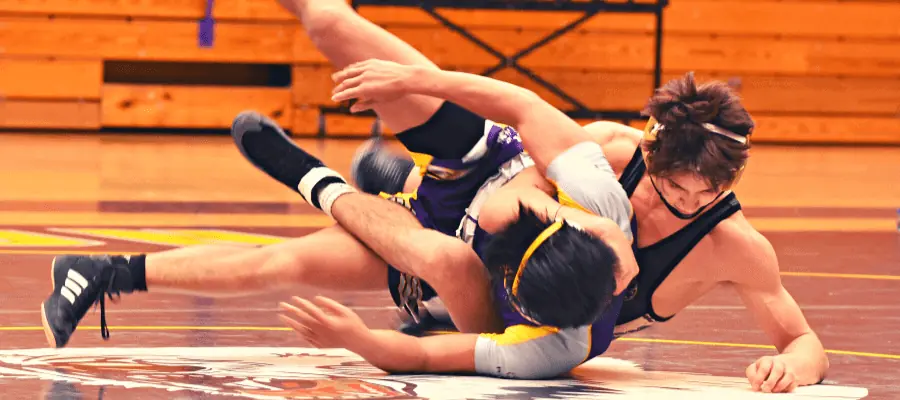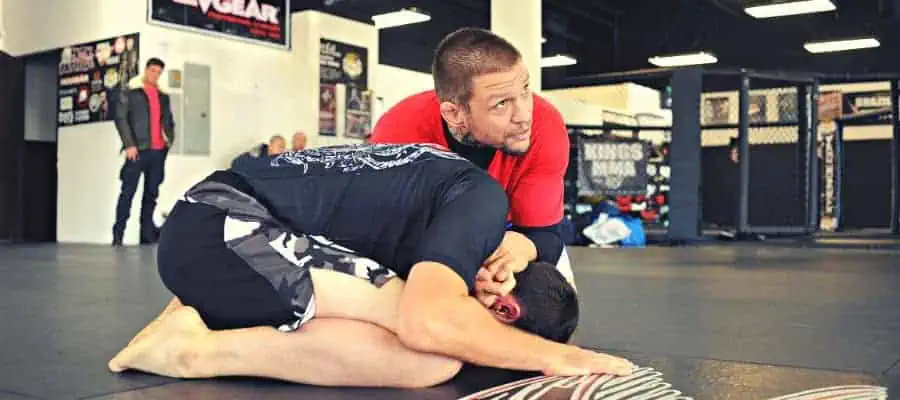The grappling world is more complex than most people believe. Several styles have been created throughout history. Some were developed independently, others as variants of classic Martial Arts. The most ancient registers of what looks like a grappling Martial Art come from Egypt.
Some tombs found in Beni Hasan have hieroglyphs that are more than 4000 years old. There might be no written register of them, but they can be as old or even more than this. Some styles are practiced by indigenous people in South America, Africa, and Asia.
Grappling Martial Arts

| BJJ | |
|---|---|
| Country Of Origin | Brazil |
| Belts System | Yes |
| Learn Difficulty | Medium |
| Injuries Level | Medium |
| Self-Defence Effectiveness | Yes |
Grappling is the general term for sports involving gripping or seizing the opponent. Many features are shared among these arts, but they all have specificities. BJJ, Jiu-Jitsu, Judo, Sambo, and Wrestling are the most common. Although there is a massive number of grappling Martial Arts, the fact is that some of them have prevailed over time.
As the name suggests, Brazilian Jiu-Jitsu came from the traditional Japanese Jiu-Jitsu. Many factors, including the excellent marketing strategy that created the UFC, led to the spread of this style. Slowly, it has replaced the older style all across the world. Currently, BJJ is, hands down, the most practiced of these Martial Arts in the world.
But, as once said, some classics never die. Judo and Classic Wrestling are Olympic sports, and this helps them to be spread everywhere. Sambo was a more endemic Martial Art, widely practiced in Russia. But, in recent years, the number of its adepts has increased worldwide.
With such a variety comes confusion. For some people, especially those who are starting to walk the Martial Arts pathway, it’s not easy to keep track. It’s even more complicated when compared to relatively contemporary art, such as BJJ. It’s essential to understand the differences between all kinds of classic grappling and the Brazilian style.
Differences between BJJ And Jiu-Jitsu

| Jiu-Jitsu | |
|---|---|
| Country Of Origin | Japan |
| Belts System | Yes |
| Learn Difficulty | Hard |
| Injuries Level | High |
| Self Defense Effectiveness | Yes |
Japanese Jiu-Jitsu, also known as Ju-Jutsu, is considered the predecessor of many grappling Martial Arts. This includes Judo, Aikido, Sambo, and, indirectly, BJJ. It can be translated as “gentle art” for its main feature of controlling the opponent using his force.
Its name can be written as Jujutsu, Ju-Jutsu, but also Jiu-Jitsu. Despite that, usually, when we talk about “Jiu-Jitsu,” we’re talking about BJJ. Also, we will choose the term Ju-Jutsu to speak about Japanese art.
Ju-Jutsu has not died as many people think. Quite the contrary. With the explosion of some of the arts derived from it, people started to look for the original style more and more. However, it has presented a growth that cannot compare to BJJ’s evolution.
Ju-Jutsu was developed for unarmed people to be able to fight the samurai of feudal Japan. Striking an armored opponent with one’s bare hands would not be effective. For this reason, this Martial Art mainly focuses on throws, holds, strangulation, and locks. But it’s not just that; this is the main difference between this Martial Art and BJJ.
Technical Differences
Besides the mentioned techniques, Ju-Jutsu also uses striking and some small weapons. The fight can develop as ground fighting, striking, or stand-up grappling. On the other hand, BJJ can begin in a standing position. Still, it’s set on the ground, and there is no striking.
The Gracie family developed BJJ in Brazil from Kano Jigoro’s Judo. The legendary fighter Mitsuyo Maeda, trained by Kano, left Japan to spread their way through the world. Eventually, Mitsuyo arrived in Brazil and became Carlos Gracie’s teacher.
Hélio Gracie also started training. However, he had problems performing many throws due to his size. For this reason, Hélio began to adapt the art to a softer version, focusing on the ground fighting and the leverage aspect of Ju-Jutsu and Judo.
That happened in the first half of the twentieth century, and BJJ has significantly evolved. Its essence, however, is the same. This Martial Art has the secrets for beating a more prominent opponent in its fundamentals.
Training Differences
For its nature, Ju-Jutsu training is also quite different from BJJ. The latter is a competitive Martial Art, while the former is not. Ju-Jutsu competitions exist, but they are infrequent and not the main point of this Martial art. For this reason, it doesn’t make sense to compare these Martial Arts in terms of rules.
This fundamental difference is reflected in training, though. BJJ training has a greater focus on endurance, strength, and stamina. For the same reason, Ju-Jutsu is less focused on repetition, a key concept for competition.
Ju-Jutsu is a Martial Art with tradition as a considerable component. Thus, its training has katas, like the ones seen in Karate. Sparring is not frequently trained in Ju-Jutsu. Conversely, BJJ is purely man-to-man combat training. Even the drills are executed with partners.
From its grandpa, BJJ kept the vest and the basic posture and techniques on the ground. But the thing is, BJJ is one constantly evolving Martial Art. In fact, what is seen today is much more complex than the art that originated from Judo.
It’s hard to imagine a BJJ competition where the Berimbolo doesn’t play a significant role. This move is not even 30 years old. Being a Martial Art in which tradition is essential, Ju-Jutsu doesn’t evolve at the same pace. The art practiced today is the same that inspired so many other grappling Martial Arts around the world more than a century ago.
Differences Between BJJ And Judo

| Judo | |
|---|---|
| Country Of Origin | Japan |
| Belts System | Yes |
| Learn Difficulty | Hard |
| Injuries Level | High |
| Self Defense Effectiveness | Yes |
Judo is the father of BJJ. Understanding their differences is the same as understanding BJJ itself. First, we need to address their similarities.
Both Martial Arts use the Gi as a vest. This reflects in training, which is quite similar. They are both effective in self-defense, and competition is their biggest goal. Among their shared techniques, there are throws, takedowns, and submissions.
Technical Differences
The main difference between them is the focus. BJJ is focused on the ground game, while Judo fights mainly take a standing stance. The first has submission as its ultimate goal. The second aims for the perfect throw, scoring an Ippon. The same score can be achieved by submission, but for its very nature, this is an exception.
The Judo fighter usually keeps a certain distance from his opponent. He moves around his prey, looking for an opportunity to attack. When he identifies the perfect moment, he advances, tries to attack, and, if failed, disengages. The fight seldomly takes place on the ground, as long-lasting engaged combat.
A BJJ fight begins similarly, but that’s it. When a fighter effectively engages, the fight will happen this way for the remaining time. It’s rare to see a fight with the fighters on their feet.
Rules Differences
From the moment a BJJ fight begins, a fighter can look for the takedown or throw in many different ways. He can also pull his opponent down the guard, bringing the fight to the ground. A BJJ fighter will score some points with a good throw or takedown, but a fight will never end for this reason only.
In Judo, depending on how the opponent falls, that may be his last moment in the competition. There are three possible scores for any technique in Judo, the Yuko, the Waza-Ari, and the Ippon. Two Waza-Aris equals an Ippon, which finishes a fight.
To get an Ippon directly, a fighter must throw an opponent on his back with impetus and control. If the throw is achieved with less force, the result is a Waza-Ari. The Yuko occurs when the success is partial, with the opponent falling sidewise. The Yuko’s role is merely to untie a match.
A BJJ fight can be finished by points at the end of the match, but never just for a fall. The way an opponent falls doesn’t affect the number of points too. A throw or takedown finishes a BJJ fight only by a technical knockout. This is very rare, though.
Despite the differences in rules, one game can strengthen the other. Falling in a non-dominant position can be very detrimental in BJJ. Judo is frequently incorporated into a BJJ fighter’s arsenal for its efficiency at throws and takedowns.
Likewise, BJJ techniques can be contained by a Judo fighter to surprise his opponent. Usually, a Judo fighter is not nearly as efficient at defending a submission as a BJJ fighter. This way, chokes or locks may effectively finish a fight.
Differences Between BJJ And Sambo

| Sambo | |
|---|---|
| Country Of Origin | Soviet Union |
| Belts System | No |
| Learn Difficulty | Medium |
| Injuries Level | High |
| Self Defense Effectiveness | Yes |
Sambo is a Russian Martial Art. The name is an acronym for “SAMozashchita Bez Oruzhiya,” which means “self-defense without weapons.” It was developed in the 1920s by the Soviet NKVD and the Red Army. Currently, it is divided into Sport Sambo and Combat Sambo.
BJJ And Sport Sambo
Sport Sambo has many similarities with BJJ. It originated from Ju-Jutsu, just like Judo, and it’s similar to its sibling Martial Art. It’s a grappling Martial Art type included in the World Wrestling Championships. This puts it along with Greco-Roman Wrestling and Freestyle Wrestling.
In Sport Sambo, an athlete can win by points or by the “total throw,” which is similar to the Ippon. Throws and pins score points. Besides that, the fight may end with a submission as well.
In addition to the same differences held by Judo when compared to BJJ, Sambo have a couple more. The first and most evident is the vest. Brazilian Jiu-Jitsu and Judo use the Gi, while Sambo uses a combination of a jacket and shorts. The first two are usually fought in a squared mat arena. In Sambo, a fight occurs in a circular arena, just like the ones used in Free-Style Wrestling.
Sambo and BJJ allow different kinds of submissions. In Sport Sambo, only arm and leg locks are allowed. BJJ has strangled, changing the style of takedowns and body positioning. Exposing the neck is fatal in Brazilian Jiu-Jitsu, but not necessarily in Sport Sambo.
The Russian Martial Art is known for the great suplexes with the opponent’s head hitting the ground. Although suplexes are allowed in BJJ, throwing the opponent with the head to the ground is not. A Sambo classic is not allowed in BJJ too.
BJJ And Combat Sambo
Combat Sambo is even more distant from BJJ. It has, basically, all techniques of Sport Sambo with the addition of striking techniques. For this reason, Combat Sambo is very similar to the modern MMA we know.
It’s not just a coincidence that many Russian fighters have stood out in recent years in the main MMA events worldwide. Many people consider Khabib “The Eagle” Nurmagomedov as the best pound-for-pound MMA fighter of all time. His Sambo techniques have helped him to keep a perfect record – 29 very convincing wins, no losses.
But if Combat Sambo differs from BJJ by adding striking techniques, it comes closer to grappling. In this style of Sambo, it’s allowed some of the submissions forbidden in Sport Sambo, including strangling. Both styles of Sambo have training systems very similar to BJJ’s. In competition sports, sparring is a routine.
Differences Between BJJ and Wrestling

| Modern Free-Style Wrestling | |
|---|---|
| Country Of Origin | GB And USA |
| Belts System | No |
| Learn Difficulty | Hard |
| Injuries Level | High |
| Self Defense Effectiveness | Yes |
Wrestling is a general term that englobes many grappling Martial Arts. However, when discussing Wrestling in a combat Martial Arts context, one usually refers to Free-Style Wrestling.
Technical Differences
The ultimate goal of the Free-Style wrestlers is to throw and pin the opponent to the mat, resulting in a winning. A pin is when you put your opponent on his back so that any part of both shoulders makes contact with the mat for two seconds. For this reason, the essential skills for a wrestler are the take-down and body control through weight distribution.
Although these skills may also be necessary for Jiu-Jitsu, submission is the primary goal. There are Jiu-Jitsu styles that favor fighting from underneath. From this point of view, being taken down, it’s not necessarily a bad thing.
A fighter may be known as “guardeiro” when he prefers to fight from behind. This strategy is called playing guard. Most styles of Wrestling don’t allow submissions. But a couple of them, such as Catch Wrestling, do, even though there are fewer submissions in Wrestling compared to BJJ.
Rules Differences
Although submissions are more a BJJ thing, some are allowed in Wrestling, which is forbidden in BJJ. A good example is a spinal lock without choke. In BJJ, one can only attack his opponent’s spine if this is part of a choke. A few Wrestling submissions, though, consist of putting pressure over the spine.
There’s no choke involved in this case. It’s a mere force to cause pain and submit the opponent. According to the Free-Style Wrestling rulebook, a scissor-lock with the feet crossed on the head, neck, or body is prohibited. On the other hand, the classic triangle choke is forbidden in most Wrestling styles.
As mentioned, BJJ rules don’t allow, under any circumstance, the suplex ending with the head or neck hitting the ground. Just like in Sambo, this may be allowed in Wrestling. For both Martial Arts, if a fight is not ended by its ending techniques, the winner is the athlete who scored more points.
In professional BJJ, it’s usually after a 10 minutes game. Whereas in Wrestling, this will happen after three two-minute rounds (sometimes three-minute rounds). As Sambo fighters, wrestlers also use vests different from the classic Gi. In this case, the Wrestling singlet is a one-piece, tight-fitting uniform usually made of elastic fabric.
This is a difference that stands out from the mere aesthetic. Many classic BJJ techniques need the Gi to be effective. For a jiujiteiro, the Gi is a part of the body. The singlet is the best vest for a wrestler because he can ignore it the whole fight.
Grabbing clothing is penalized in Wrestling. While on the contrary, it’s a commonplace in BJJ. The exception is the No-Gi BJJ, which replaces the Gi with tight-fitting clothes, like the rashguard.
Differences Between BJJ and Grappling

| Grappling / No-Gi Jiu-Jitsu | |
|---|---|
| Country Of Origin | USA / Japan |
| Belts System | No |
| Learn Difficulty | Medium |
| Injuries Level | Medium |
| Self Defense Effectiveness | Yes |
As mentioned, grappling is usually employed as an umbrella term to describe many Martial Arts. It’s used in opposition to striking in combat sports. It may have joint locks, chokes, take-downs, and throws. It englobes any Martial Art in which the goal is holding the opponent to subdue him.
Considering this, all Martial Arts we have been talking about until this moment are “grappling Martial Arts.” A grappling fight can end by surrendering points, medical intervention, or an ending attack, as the Ippon in Judo.
Submission Grappling is known as Submission Fighting, Combat Grappling, or No-Gi Jiu-Jitsu. These are the essential features that define Grappling. But, sometimes, the word may also mean a specific fight style: Submission Grappling.
Technical Differences
The most evident difference between Brazilian Jiu-Jitsu and No-Gi is the vestment. But this has consequences that go way beyond the layman’s sight. Just for not using a Gi, there are a bunch of BJJ techniques that athletes cannot use in Grappling. Besides, some techniques can be used but are impractical. Some throws are an excellent example of it.
In a Grappling fight, one is much more likely to see a double leg than an Uchi-Mata, a Judo, and BJJ typical throw. There are plenty of tries to adapt the clock choke for No-Gi, but this is not a technique one will quickly see in any championship. It’s just too prone to fail without the Gi.
Speed and strength are more critical in No-Gi than in traditional BJJ. This is because it’s harder to control the opponent without a Gi. Although these features are also essential for the BJJ fighter, he would instead focus on refining his technique.
Rules Differences
When it comes to rules, there is no better source than the rulebook from the IBJJF. The first difference is that holding the clothes is forbidden in No-Gi. Some techniques are allowed only in this style, such as the heel hook, locks twisting the knees, and knee reaping.
These techniques are forbidden even for BJJ black belts. At pretty much everything else, BJJ and No-Gi are the same.
Recent Posts
What is Manachai's Fighting Style? Unveiling Muay Thai Mastery
Manachai, a celebrated figure in the Muay Thai world, has captivated audiences with his exemplary martial prowess. Hailing from the heartlands of Thailand, his name is synonymous with the art of...
What Was Chamuekpet Hapalang's Fighting Style? Unveiling Techniques
Chamuekpet Hapalang was a renowned figure in the world of Muay Thai (record 200-48-2), embodying a fusion of Muay Bouk and Muay Khao styles. Originating from Thailand, the art of Muay Thai is known...
